

|
|
| « Previous | Next » |
Northwestern Scotland |
Sunday, 10 August 2003 |
| written by Sterling |
As you've probably gathered from the introductions to the last couple of articles, we're a bit tardy getting some of these out. So once again, the events you're about to witness took place about a month ago.
We set off from Manchester with Teresa's brother Vinny and his partner Aileen, bound for the northwest coast of Scotland on the real "holiday" part of this UK trip. In the context of Britain, this is a very long excursion, somewhere over 700 miles one way. And it feels distant, not just in the time it takes to drive but in the changing character of the land. At the English border, the countrysides are indistinguishable, but before too long population thins and empty hillsides begin to appear. Urban sprawl gives way to forests and lochs, motorways dwindle to A-roads which eventually lose all but one lane themselves. By the time you approach the northern coast, comfortably beyond the 58th parallel, even the forests have slipped behind you and no settlement is larger than a few dozen houses, perhaps with a pub or tea shop thrown in if you're lucky.
Our first stop was the village of Inverary, welcoming enough if only because it's obviously overrun by tourists at every opportunity. Within The Trossachs National Park on the shore of Loch Fyne, it's northerly enough to be in the "real" Scottish countryside, but still accessible for a weekend from Glasgow.
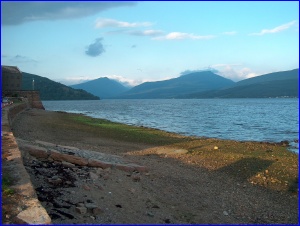 It was built in 1745 by the Duke of Argyll, purportedly so that the riffraff wouldn't be too close to the small palace he constructed for himself a quarter-mile north. On the Sunday that we arrived, the village appeared to be the focus of a motorcycle gathering, presenting an interesting contrast from its American counterparts. Most of the bikes were Japanese street racers rather than the chromed Harleys that are de rigeur for such groups in the States, and the riders wore multicolored racing leathers instead of uninterrupted black, but still acquitted themselves well with tattoos.
It was built in 1745 by the Duke of Argyll, purportedly so that the riffraff wouldn't be too close to the small palace he constructed for himself a quarter-mile north. On the Sunday that we arrived, the village appeared to be the focus of a motorcycle gathering, presenting an interesting contrast from its American counterparts. Most of the bikes were Japanese street racers rather than the chromed Harleys that are de rigeur for such groups in the States, and the riders wore multicolored racing leathers instead of uninterrupted black, but still acquitted themselves well with tattoos.
We didn't know it yet, but Inverary was already far enough north for us to begin experiencing what would become one of the hallmarks of this jaunt: endless daylight. We set off on the 29th of June, only a week past the summer solstice, and northern Scotland just doesn't experience true darkness at that time of year. We found this both liberating and disorienting.
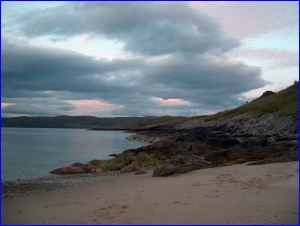 Our sleep patterns, which had only recently cleared the last vestiges of jet lag, suffered yet again; it takes a while to shake the feeling of get up when you wake to natural light at the window, despite the clock's insistence that it's only 2 AM. But on the shores of the Kyle of Tongue, at the same latitude as Juneau, Alaska, we were happily beachcombing at 11:30 PM.
Our sleep patterns, which had only recently cleared the last vestiges of jet lag, suffered yet again; it takes a while to shake the feeling of get up when you wake to natural light at the window, despite the clock's insistence that it's only 2 AM. But on the shores of the Kyle of Tongue, at the same latitude as Juneau, Alaska, we were happily beachcombing at 11:30 PM.
Accordingly, we had many miles yet to travel from Inverary, so we set off again the next morning for the peninsula of Applecross. This was arguably the most remote - and most spectacular - stopping point of the trip. The peninsula itself, about ten miles long and as many wide, is really only inhabited around bits of its northern and western perimeters. The interior consists largely of rugged mountains crossed only by a single-lane, switchbacked track, the Bealach Na Ba road; until the late 1970s this was the only overland route to the settlements by the sea. There is now also "the coast road", longer and no less narrow but at least flatter and less prone to closure in winter.
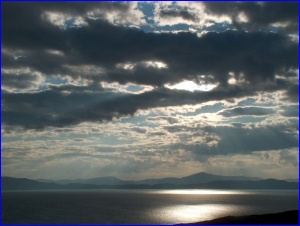 But Applecross itself is worth every harrowing inch you have to travel. The main village is strung along the water's edge, with a clear view across the Inner Sound to the mountains on the Isle of Skye, and the effect is no less than stunning. I'm a sucker for mountains myself, and Teresa is inexorably drawn to the sea; here is a place where we find our meet. Then add deserted white-sand beaches and brooding moorlands, topped by the complex interplay of light and cloud during sunsets that last for hours.
But Applecross itself is worth every harrowing inch you have to travel. The main village is strung along the water's edge, with a clear view across the Inner Sound to the mountains on the Isle of Skye, and the effect is no less than stunning. I'm a sucker for mountains myself, and Teresa is inexorably drawn to the sea; here is a place where we find our meet. Then add deserted white-sand beaches and brooding moorlands, topped by the complex interplay of light and cloud during sunsets that last for hours.
I want to live here. I want one of the cottages in Ardban that's not reachable by road, to moor a sailboat in the sheltered cove and spend the long days on these magical waters where the highlands meet the sea.
It is a wonderful place.
But leave we did, after only a couple of days, bound for Achiltibuie. Go ahead, spend a moment working out the pronunciation; you won't get it right, but hopefully you'll enjoy the ride.
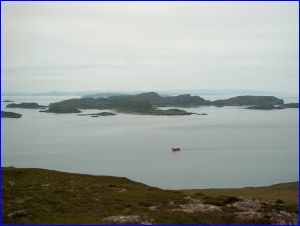 Greater Achiltibuie ;-) is a loose cluster of villages on the shore of another peninsula, this time overlooking the Summer Isles. They're not as spectacular as Skye, but they're much more immediate, only a mile or two offshore. It's not clear to me how many visitors the area gets in the summer (though I suspect it's quite a few, the tour boat we went out on was nearly full), but it's even less clear to me where said visitors eat dinner. The area's two restaurants - pubs really - have between them a total of seven tables. Not surprisingly, reservations are recommended. But what is surprising, given the lack of competition, is the excellent caliber of fare offered by both establishments - it was among the best food we had on the trip.
Greater Achiltibuie ;-) is a loose cluster of villages on the shore of another peninsula, this time overlooking the Summer Isles. They're not as spectacular as Skye, but they're much more immediate, only a mile or two offshore. It's not clear to me how many visitors the area gets in the summer (though I suspect it's quite a few, the tour boat we went out on was nearly full), but it's even less clear to me where said visitors eat dinner. The area's two restaurants - pubs really - have between them a total of seven tables. Not surprisingly, reservations are recommended. But what is surprising, given the lack of competition, is the excellent caliber of fare offered by both establishments - it was among the best food we had on the trip.
Some credit for this is likely due to the exceedingly fresh veg both pubs have access to, and for this we can thank the Achiltibuie Hydroponicum. This is what passes for a tourist attraction in northwest Scotland, and our guidebook recommended a visit to the "space station-like" structure. We were dubious - from the outside, it looks far more like a slightly rundown greenhouse than like Mir - but the rain had settled in for the afternoon, so we thought we'd give it a shot. We soon discovered our mistake.
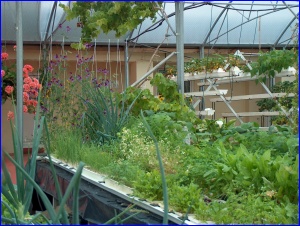 Inside it's a whole different story, a living testimonial to growing fantastic plants without soil, and it really does have the feel of Silent Running, if not Voyager's aeroponics bay. It was an interesting contrast to visiting the Eden Project the previous week; the Hydroponicum isn't about "theater", it's about a better way of growing tomatoes and bananas.
Inside it's a whole different story, a living testimonial to growing fantastic plants without soil, and it really does have the feel of Silent Running, if not Voyager's aeroponics bay. It was an interesting contrast to visiting the Eden Project the previous week; the Hydroponicum isn't about "theater", it's about a better way of growing tomatoes and bananas.
Our lodging near Achiltibuie, like the rest of the trip, was at a small bed & breakfast. For many Americans, B&Bs conjure up images of romantic escapes to the Oregon coast or Vermont mountains, complete with porch swings and antique four-poster beds. Our experience in Scotland was frequently a bit less, ummm, sophisticated, with results that were sometimes irritating, sometimes hilarious. And nowhere more so than here� Before we left the US, Vinny had assumed the role of cruise director, planning the Scottish trip and booking our accommodation along the way. Of the Achiltibuie stop, all he would say was "The landlady sounds like Mrs. Doubtfire."
Well, he was right, but as it turned out that was just the beginning - she was a bundle of entertaining habits. The entire house was festooned with handwritten notes:
Rooms must be vacated between 10:30 AM and 5 PM
Please don't lean on the glass
Caution, radiators are hot
and so on. The two bedrooms, while comfortable enough, had last been decorated in the depths of the 1950s - OK, I suppose this will be antique furniture before much longer - and were inscrutably labeled "Bedroom 2" and "Bedroom 3". The need for this was made clear our first evening there, when we were introduced to the Menu Ritual: on entering the house after dinner, we were summoned to the living room and gathered around the (handwritten) breakfast menu high on a shelf to make our decisions for the morning meal. Vinny, never one to tarry on matters gastronomical, began to place his order, only to be cut off by Doubtfire's implacable trill: "Bedroom two first!"
We later speculated that Bedroom 1 belonged to Mr. Doubtfire (whom we'd only glimpsed lurking around the woodshed or the far end of the yard), and for the past twenty years he'd been made to stand in the living room and place his breakfast order before the guests came in for the evening.
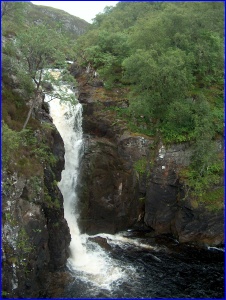 And the morning meal itself, "the full fry", was further enlivened when the good Euphegenia inquired as to our plans for the day.
And the morning meal itself, "the full fry", was further enlivened when the good Euphegenia inquired as to our plans for the day.
"Well, we'd thought of hiking up to Kirkaig Falls."
"Ah yes, Kirkaig Falls, a very popular walk with the tourists. The midges will likely eat you alive up there, you'd be best to wrap towels around your heads before going up."
"Um, towels, right. Then this afternoon, we're considering the boat trip out around the Summer Isles."
"Oh, John's boat trip, also verrry popular. You'll want to wear sturdy boots, so you can leap ashore in case he dashes the boat on the rocks. Why, just this past Sunday a freighter carrying poison ran aground and sank out there. You'll probably see the Coastguard still cleaning it up. Well, have a wonderful day of it."
Undaunted, we followed through with both plans.
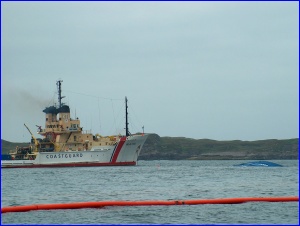 Though there were a good few midges up near the Falls and we did indeed see the sunken freighter, our boat's captain somehow managed to avoid killing us all, and overall the day rated lower on the Adventurometer than had slogging our way through a trackless peat bog on Applecross. We even got a creditable cup of tea during our stop on Tanera Mor, the largest Isle.
Though there were a good few midges up near the Falls and we did indeed see the sunken freighter, our boat's captain somehow managed to avoid killing us all, and overall the day rated lower on the Adventurometer than had slogging our way through a trackless peat bog on Applecross. We even got a creditable cup of tea during our stop on Tanera Mor, the largest Isle.
But this brings up an important point about traditional British B&Bs. Though you might (if you're lucky) have your own bathroom, and maybe even a shared sitting room, at the end of the day you're staying in someone else's house - and someone you don't know, at that. It's only made more weird by the fact that they cook you breakfast. We found ourselves whispering and tiptoeing around for virtually the entire trip, and realized toward the end that it was actually weighing on us quite heavily. Especially Teresa and myself - although we travel all the time, we ordinarily take our house with us, so we're accustomed to having our own space.
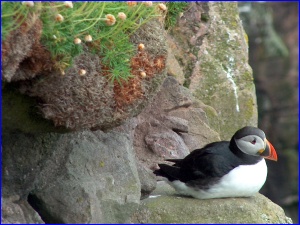 Our next destination northward was Scourie, an unremarkable (but predictably lovely) village where, to break up the monotony, we got some of the worst food of the trip. Here we stayed in a B&B that had originally been built as a hunting lodge for the Duke of Sutherland; its most notable feature is a formal garden containing the northernmost palm trees known in the world.
Scourie was also our base for a day trip to Handa Island, just offshore and only inhabited by the many thousands of seabirds that nest there in the summer months. Well, obviously it was summer when we arrived, so luckily the birds were home, all 200,000 or so of them - mostly guillemots, but with a healthy sprinkling of razorbills, petrels, and skuas, as well as the odd puffin to add a dash of color. Most of the birds favor the cliffs and seastacks around the island's northwestern shore, making for incredible density on every ledge. For us, Handa ranks right up there with the elephant seals at Piedras Blancas for "most like being in a nature documentary"; you can almost hear David Attenborough describing the avian multitudes.
Our next destination northward was Scourie, an unremarkable (but predictably lovely) village where, to break up the monotony, we got some of the worst food of the trip. Here we stayed in a B&B that had originally been built as a hunting lodge for the Duke of Sutherland; its most notable feature is a formal garden containing the northernmost palm trees known in the world.
Scourie was also our base for a day trip to Handa Island, just offshore and only inhabited by the many thousands of seabirds that nest there in the summer months. Well, obviously it was summer when we arrived, so luckily the birds were home, all 200,000 or so of them - mostly guillemots, but with a healthy sprinkling of razorbills, petrels, and skuas, as well as the odd puffin to add a dash of color. Most of the birds favor the cliffs and seastacks around the island's northwestern shore, making for incredible density on every ledge. For us, Handa ranks right up there with the elephant seals at Piedras Blancas for "most like being in a nature documentary"; you can almost hear David Attenborough describing the avian multitudes.
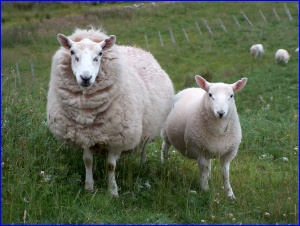 By the time we returned to the Scottish mainland, we had nearly run out of north, so we began to turn eastward across the top of the country. The Outer Hebrides were in sight as we walked out to see the Old Man of Stoer (a well-known seastack), but the land we were crossing had become almost otherworldly, a wrinkled grass-scape broken by rock outcroppings and small lochs, rarely supporting anything larger than stunted heather. And sheep.
By the time we returned to the Scottish mainland, we had nearly run out of north, so we began to turn eastward across the top of the country. The Outer Hebrides were in sight as we walked out to see the Old Man of Stoer (a well-known seastack), but the land we were crossing had become almost otherworldly, a wrinkled grass-scape broken by rock outcroppings and small lochs, rarely supporting anything larger than stunted heather. And sheep.
Our few days in the far north were marked by more rain than we'd encountered thus far, requiring the odd afternoon in a pub or imposing on our hosts' hospitality. This was in a B&B that didn't kick us out between 10:30 and 5, a former customs house on the shore of the saltwater Loch Eriboll. And I do mean right on the shore; our landlady assured us that spring tides would reach the third step of the house! Fortunately, our rooms were on the second floor, which also included a lovely conservatory - the perfect spot when the rain was coming in horizontally.
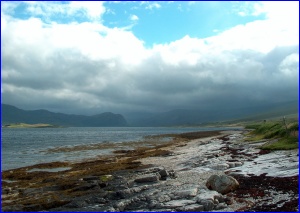 The volatile weather added a wonderful ambience to the already beautiful loch, dark clouds mixing it up with bright sunshine and frequent rainbows, with the peak of Ben Hope slipping in and out of view. Our good fortune continued in the evening, this being one of our few lodgings that served an evening meal on the premises - and a splendid one at that.
The volatile weather added a wonderful ambience to the already beautiful loch, dark clouds mixing it up with bright sunshine and frequent rainbows, with the peak of Ben Hope slipping in and out of view. Our good fortune continued in the evening, this being one of our few lodgings that served an evening meal on the premises - and a splendid one at that.
Alas, our time in Scotland was already drawing to a close, but since we'd meandered our way so far north it made sense to split the drive back to Manchester across two days. We stopped for a day in between back in Trossachs, at the engagingly-named Fasnacloich, staying in a self-styled "cottage" alongside another tiny loch. Aileen - who maintains that she became a police officer because it allows her to be professionally nosy - soon ascertained that the proprietor was the former owner and headmaster of an upmarket private school, now so far down on his luck that he has to take in the likes of us as lodgers. Whatever their provenance, our hosts certainly did a good job of maintaining a posh feel; this was the only B&B where we were served high tea, and one of just two with real silver on the breakfast table.
During our last full day, we got it in our heads to walk around the neighboring loch, but had gotten less than a hundred yards from the house when a farmer in the next field with a highland cow called out, "Are you feeling strong?"
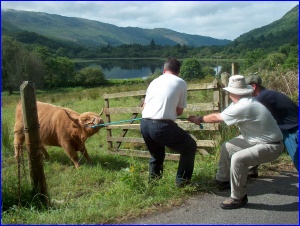 A bit taken aback, we nonetheless soon determined that he was serious; this particular cow had gone stubborn, and was unwilling to join her two compatriots in the farmer's nearby trailer. Well, Vinny and I pitched in on the ropes, but she wasn't going anywhere and to make a long story short, it took the assistance of two more strong men to finally get her aboard. Where'd they come from, you might ask? Well, the farmer had conveniently parked his truck blocking the narrow lane - if you wanted to drive past, you had better pitch in. A good 7 on the Adventurometer, but at least it was one of the other guys who got his foot shat upon by the distressed beast.
A bit taken aback, we nonetheless soon determined that he was serious; this particular cow had gone stubborn, and was unwilling to join her two compatriots in the farmer's nearby trailer. Well, Vinny and I pitched in on the ropes, but she wasn't going anywhere and to make a long story short, it took the assistance of two more strong men to finally get her aboard. Where'd they come from, you might ask? Well, the farmer had conveniently parked his truck blocking the narrow lane - if you wanted to drive past, you had better pitch in. A good 7 on the Adventurometer, but at least it was one of the other guys who got his foot shat upon by the distressed beast.
An ironic footnote to this tale: Upon arrival in the USA, Customs makes you fill out a form that includes the question, "Have you been in contact with any farm animals?" If you answer Yes, they stamp your form C & D (which stands for Clean and Disinfect) and ask you what shoes you were wearing at the time. So the upshot is that two years ago the INS was treating us like dirt, and now they're cleaning our boots. Go figure.
| « Previous | [ Photos ] | Next » |
This log entry is available in audio format. Please click for purchase information.
| Home | Log | Notes | Maps | Contact |